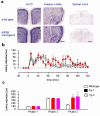Plasticity of NMDA receptor NR2B subunit in memory and chronic pain
- PMID: 19192303
- PMCID: PMC2644299
- DOI: 10.1186/1756-6606-2-4
Plasticity of NMDA receptor NR2B subunit in memory and chronic pain
Abstract
Glutamatergic synapses play critical roles in brain functions and diseases. Long-term potentiation (LTP) is a most effective cellular model for investigating the synaptic changes that underlie learning as well as brain disease--although different molecular mechanisms are likely involved in LTP in physiological and pathological conditions. In the case of learning, N-methyl-D-aspartate (NMDA) receptor is known to be important for triggering learning-related plasticity; alpha-amino-3-hydroxy-5-methyl-4-isoxazolepropionic (AMPA) receptors are thought to be important for the expression of synaptic changes. In this review, I will examine recent evidence on the novel roles of NMDA receptors, in particular NR2B subunit-containing NMDA receptors in learning and chronic pain. A positive feedback control of NR2B receptor subunit is proposed to explain cortical sensitization involved in chronic pain, but not learning and memory.
Figures




Similar articles
-
Post-translational modification of NMDA receptor GluN2B subunit and its roles in chronic pain and memory.Semin Cell Dev Biol. 2011 Jul;22(5):521-9. doi: 10.1016/j.semcdb.2011.06.003. Epub 2011 Jun 17. Semin Cell Dev Biol. 2011. PMID: 21704719 Review.
-
Targeting the NMDA receptor subunit NR2B for the treatment of neuropathic pain.Neurotherapeutics. 2009 Oct;6(4):693-702. doi: 10.1016/j.nurt.2009.07.008. Neurotherapeutics. 2009. PMID: 19789073 Free PMC article. Review.
-
Hippocampal long-term synaptic plasticity and signal amplification of NMDA receptors.Crit Rev Neurobiol. 2006;18(1-2):71-84. doi: 10.1615/critrevneurobiol.v18.i1-2.80. Crit Rev Neurobiol. 2006. PMID: 17725510 Review.
-
NMDA and AMPA receptors: old channels, new tricks.Trends Neurosci. 2007 Jun;30(6):284-91. doi: 10.1016/j.tins.2007.03.012. Epub 2007 Apr 6. Trends Neurosci. 2007. PMID: 17418904 Review.
-
NMDARs Containing NR2B Subunit Do Not Contribute to the LTP Form of Hippocampal Plasticity: In Vivo Pharmacological Evidence in Rats.Int J Mol Sci. 2021 Aug 12;22(16):8672. doi: 10.3390/ijms22168672. Int J Mol Sci. 2021. PMID: 34445376 Free PMC article.
Cited by
-
Additive Effects of Environmental Enrichment and Ketamine on Neuropathic Pain Relief by Reducing Glutamatergic Activation in Spinal Cord Injury in Rats.Front Neurosci. 2021 Mar 22;15:635187. doi: 10.3389/fnins.2021.635187. eCollection 2021. Front Neurosci. 2021. PMID: 33828447 Free PMC article.
-
Corticosteroids: way upstream.Mol Brain. 2010 Jan 11;3:2. doi: 10.1186/1756-6606-3-2. Mol Brain. 2010. PMID: 20180948 Free PMC article. Review.
-
Short-term synaptic plasticity in the nociceptive thalamic-anterior cingulate pathway.Mol Pain. 2009 Sep 4;5:51. doi: 10.1186/1744-8069-5-51. Mol Pain. 2009. PMID: 19732417 Free PMC article. Review.
-
Tapentadol in pain management: a μ-opioid receptor agonist and noradrenaline reuptake inhibitor.CNS Drugs. 2011 May;25(5):359-70. doi: 10.2165/11589080-000000000-00000. CNS Drugs. 2011. PMID: 21476608 Review.
-
Multifactorial determinants of cognition - Thyroid function is not the only one.BBA Clin. 2015 Apr 22;3:289-98. doi: 10.1016/j.bbacli.2015.04.002. eCollection 2015 Jun. BBA Clin. 2015. PMID: 26672993 Free PMC article. Review.
References
-
- Le Roux N, Amar M, Moreau A, Fossier P. Involvement of NR2A- or NR2B-containing N-methyl-D-aspartate receptors in the potentiation of cortical layer 5 pyramidal neurone inputs depends on the developmental stage. Eur J Neurosci. 2007;26:289–301. doi: 10.1111/j.1460-9568.2007.05671.x. - DOI - PMC - PubMed
-
- Zhang XH, Liu F, Chen Q, Zhang CL, Zhuo M, Xiong ZQ, Li BM. Conditioning-strength dependent involvement of NMDA NR2B subtype receptor in the basolateral nucleus of amygdala in acquisition of auditory fear memory. Neuropharmacology. 2008;55:238–246. doi: 10.1016/j.neuropharm.2008.05.030. - DOI - PubMed
Publication types
MeSH terms
Substances
Grants and funding
LinkOut - more resources
Full Text Sources
Other Literature Sources
Medical

